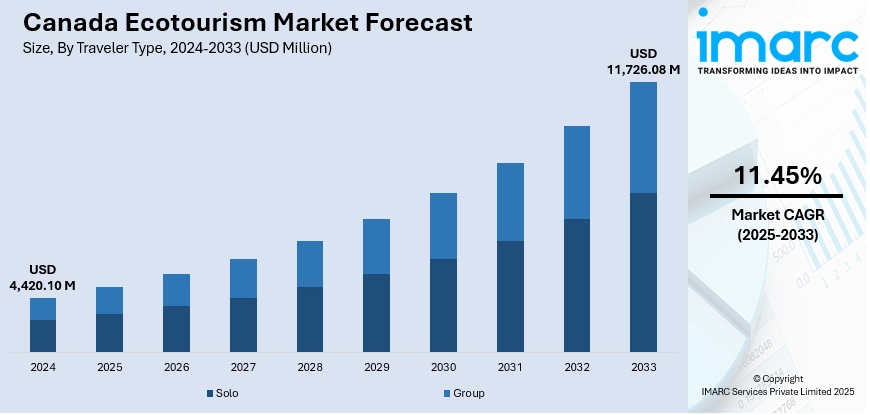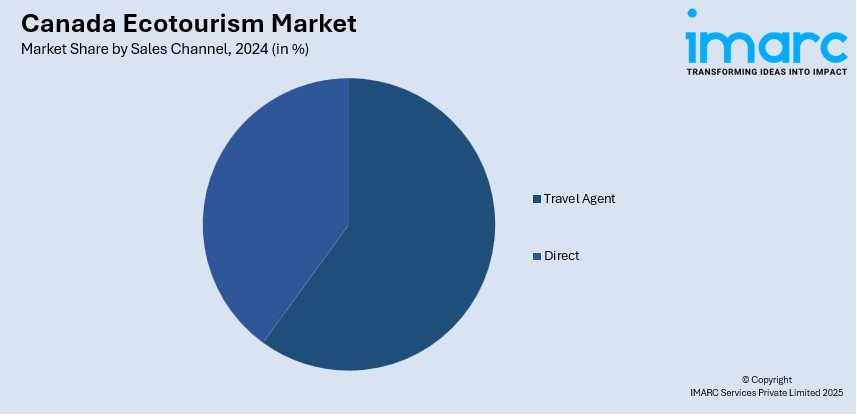
Canada Ecotourism Market Size, Share, Trends and Forecast by Traveler Type, Age Group, Sales Channel, and Region, 2025-2033
Canada Ecotourism Market Overview:
The Canada ecotourism market size reached USD 4,420.10 Million in 2024. The market is projected to reach USD 11,726.08 Million by 2033, exhibiting a growth rate (CAGR) of 11.45% during 2025-2033. The market is driven by growing consumer consciousness of preserving the environment and adopting environmentally friendly travel patterns. In addition to this, the implementation of government policies and encouraging initiatives promote green tourism development in Canada's varied natural landscape. Moreover, growing demand for unique, low-impact travel experiences continues to attract both local and global tourists, which is an important factor augmenting the Canada ecotourism market share.
|
Report Attribute
|
Key Statistics
|
|---|---|
|
Base Year
|
2024 |
|
Forecast Years
|
2025-2033
|
|
Historical Years
|
2019-2024
|
| Market Size in 2024 | USD 4,420.10 Million |
| Market Forecast in 2033 | USD 11,726.08 Million |
| Market Growth Rate 2025-2033 | 11.45% |
Canada Ecotourism Market Trends:
Growing Preference for Sustainable Accommodation and Low-Impact Infrastructure
One prominent trend shaping the market is the increasing preference for sustainable lodging and low-impact facilities. Travelers are seeking accommodation options that align with environmental stewardship, including eco-lodges, off-grid cabins, and wilderness retreats designed with a minimal ecological footprint. Operators are responding by integrating renewable energy systems, water conservation technologies, and locally sourced building materials. For instance, on May 23, 2024, Baillie Lodges’ Clayoquot Wilderness Lodge reopened for the 2024 season. The lodge introduced significant sustainability upgrades, including a solar-and-battery microgrid expected to cut diesel use by 80% and reduce carbon emissions by approximately 480,000 kg annually. Additional enhancements include guest e-bikes and locally inspired interior updates that celebrate the region’s First Nations heritage. In addition to this, many properties now engage visitors through interpretive programs that highlight sustainable living and conservation practices. This growing demand encourages developers and communities to pursue green building certifications like LEED or Canada’s Green Key Eco-Rating. Furthermore, the emphasis on sustainable infrastructure not only appeals to conscious travellers but also supports regional conservation goals by minimizing habitat disturbance. As consumers increasingly value authentic, environmentally responsible stays, properties that demonstrate measurable sustainability are better positioned to attract repeat visitors and maintain strong partnerships with local stakeholders.

To get more information on this market, Request Sample
Indigenous-Led Ecotourism Experiences
The rise of Indigenous-led ecotourism ventures is a significant factor contributing to the Canada ecotourism market growth. Many First Nations, Métis, and Inuit communities are leveraging traditional knowledge and stewardship practices to offer authentic experiences that connect visitors to the land and local culture. These initiatives range from guided nature walks and wildlife observation to storytelling, craft workshops, and cultural festivals. Operators often emphasize respect for sacred sites and sustainable use of natural resources, promoting education around Indigenous conservation ethics. Apart from this, federal and provincial funding programs increasingly prioritize Indigenous tourism development, enabling communities to build capacity and infrastructure. Notably, on March 5, 2025, Canada's Minister of Tourism announced the recipients of funding under the Indigenous Tourism Fund’s Signature Experiences Stream (SITES), supporting ten culturally immersive, Indigenous-led tourism projects across Canada. These include developments such as the Hôtel-Musée Premières Nations in Quebec, Mādahòkì Farm in Ontario, and new eco-cabins at Point Grondine Park, with each project receiving between USD 500,000 and USD 1 Million. The funding is expected to draw an estimated 187,000 additional tourists, create approximately 200 jobs, and generate new revenue opportunities in the market. As visitors seek deeper connections with Canada’s diverse heritage, Indigenous-led ecotourism stands out for its authenticity, direct community benefit, and ability to foster cross-cultural understanding.
Canada Ecotourism Market Segmentation:
IMARC Group provides an analysis of the key trends in each segment of the market, along with forecasts at the country and regional levels 2025-2033. Our report has categorized the market based on traveler type, age group, and sales channel.
Traveler Type Insights:
- Solo
- Group
The report has provided a detailed breakup and analysis of the market based on the traveler type. This includes solo and group.
Age Group Insights:
- Generation X
- Generation Y
- Generation Z
A detailed breakup and analysis of the market based on the age group have also been provided in the report. This includes generation X, generation Y, and generation Z.
Sales Channel Insights:

- Travel Agent
- Direct
The report has provided a detailed breakup and analysis of the market based on the sales channel. This includes travel agent and direct.
Regional Insights:
- Ontario
- Quebec
- Alberta
- British Columbia
- Others
The report has also provided a comprehensive analysis of all the major regional markets, which include Ontario, Quebec, Alberta, British Columbia, and others.
Competitive Landscape:
The market research report has also provided a comprehensive analysis of the competitive landscape. Competitive analysis such as market structure, key player positioning, top winning strategies, competitive dashboard, and company evaluation quadrant has been covered in the report. Also, detailed profiles of all major companies have been provided.
Canada Ecotourism Market News:
- On May 6, 2025, FinDev Canada has committed USD 15 Million in capital to EcoEnterprises Partners IV, an impact-driven, women-owned investment fund aimed at supporting up to 20 small and medium-sized enterprises (SMEs) across Latin America that champion biodiversity conservation, climate solutions, and women’s economic empowerment. The Fund, aiming for a USD 150 Million final close with partners like IDB Invest and FMO, will allocate half its investments toward natural ecosystem protection, including sustainable forestry, ecotourism, ag-tech, and renewable energy, with a goal of achieving a carbon-neutral portfolio by 2030.
Canada Ecotourism Market Report Coverage:
| Report Features | Details |
|---|---|
| Base Year of the Analysis | 2024 |
| Historical Period | 2019-2024 |
| Forecast Period | 2025-2033 |
| Units | Million USD |
| Scope of the Report |
Exploration of Historical Trends and Market Outlook, Industry Catalysts and Challenges, Segment-Wise Historical and Future Market Assessment:
|
| Traveler Types Covered | Solo, Group |
| Age Groups Covered | Generation X, Generation Y, Generation Z |
| Sales Channels Covered | Travel Agent, Direct |
| Regions Covered | Ontario, Quebec, Alberta, British Columbia, Others |
| Customization Scope | 10% Free Customization |
| Post-Sale Analyst Support | 10-12 Weeks |
| Delivery Format | PDF and Excel through Email (We can also provide the editable version of the report in PPT/Word format on special request) |
Key Questions Answered in This Report:
- How has the Canada ecotourism market performed so far and how will it perform in the coming years?
- What is the breakup of the Canada ecotourism market on the basis of traveler type?
- What is the breakup of the Canada ecotourism market on the basis of age group?
- What is the breakup of the Canada ecotourism market on the basis of sales channel?
- What is the breakup of the Canada ecotourism market on the basis of region?
- What are the various stages in the value chain of the Canada ecotourism market?
- What are the key driving factors and challenges in the Canada ecotourism market?
- What is the structure of the Canada ecotourism market and who are the key players?
- What is the degree of competition in the Canada ecotourism market?
Key Benefits for Stakeholders:
- IMARC’s industry report offers a comprehensive quantitative analysis of various market segments, historical and current market trends, market forecasts, and dynamics of the Canada ecotourism market from 2019-2033.
- The research report provides the latest information on the market drivers, challenges, and opportunities in the Canada ecotourism market.
- Porter's five forces analysis assist stakeholders in assessing the impact of new entrants, competitive rivalry, supplier power, buyer power, and the threat of substitution. It helps stakeholders to analyze the level of competition within the Canada ecotourism industry and its attractiveness.
- Competitive landscape allows stakeholders to understand their competitive environment and provides an insight into the current positions of key players in the market.
Need more help?
- Speak to our experienced analysts for insights on the current market scenarios.
- Include additional segments and countries to customize the report as per your requirement.
- Gain an unparalleled competitive advantage in your domain by understanding how to utilize the report and positively impacting your operations and revenue.
- For further assistance, please connect with our analysts.
 Request Customization
Request Customization
 Speak to an Analyst
Speak to an Analyst
 Request Brochure
Request Brochure
 Inquire Before Buying
Inquire Before Buying




.webp)




.webp)












